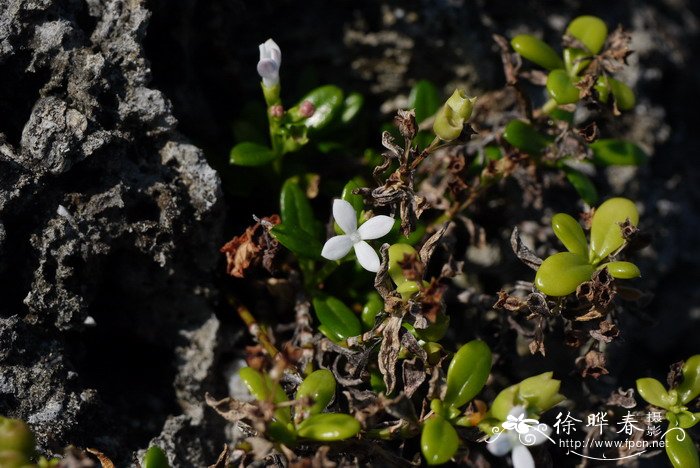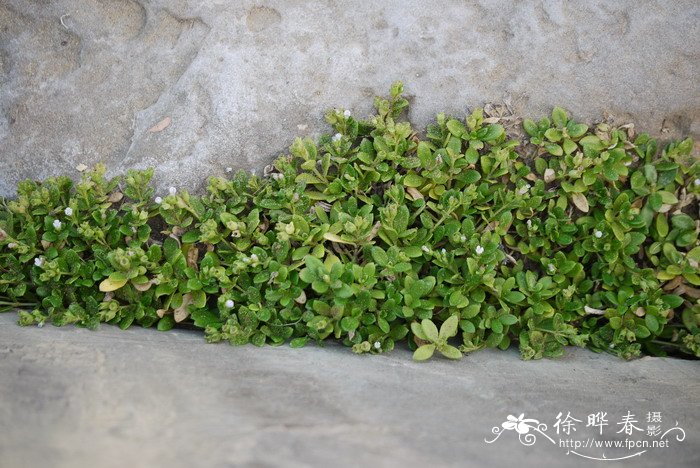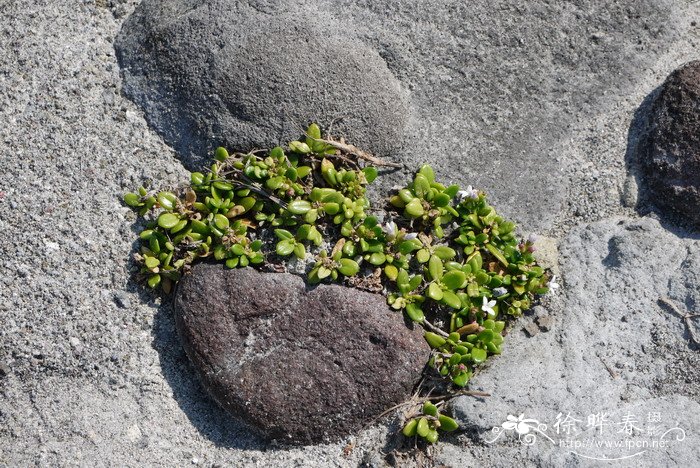肉叶耳草Hedyotis strigulosa
中文名(Chinese Name):肉叶耳草
学名(Scientific Name):Hedyotis strigulosa (Bartl. ex DC.) Fosberg
英文名(English Common Name):
别名(Chinese Common Name):
异名(Synonym):Hedyotis coreana Lévl. Oldenlandia crassifolia DC. Oldenlandia paniculata var. parvifolia A. Gray ex Maxim. Hedyotis biflora var. parvifolia Hook. & Arn. Hedyotis strigulosa var. coreana (H.Lév.) T.Yamaz. Hedyotis strigulosa var. luxurians (Hatus.) T.Yamaz. Hedyotis strigulosa var. parvifolia (Hook. & Arn.) T.Yamaz. Hedyotis coreana var. luxurians Hatus. Hedyotis albidopunctata (Merr.) Fosberg Oldenlandia strigulosa Bartl. ex DC. Hedyotis sarcophylla Steud. Hedyotis rennellensis Fosberg Oldenlandia albidopunctata Merr. Thecagonum strigulosum (Bartl. ex DC.) Terrell & H.Rob.
科属(Family & Genus):茜草科Rubiaceae耳草属Hedyotis
形态特征(Description):
分布(Distribution):
用途(Use):
引自中国植物志英文版:FOC Vol. 19 Page 151, 155, 169, 170
Hedyotis strigulosa (Bartling ex Candolle) Fosberg, Smithsonian Contr. Bot. 45: 28. 1980.
肉叶耳草 rou ye er cao| Rubiaceae | Hedyotis
Oldenlandia strigulosa Bartling ex Candolle, Prodr. 4: 427. 1830; Hedyotis coreana H. Léveillé; H. taiwanensis S. F. Huang & J. Murata ["taiwanense"]; Thecagonum strigulosum (Bartling ex Candolle) Terrell & H. Robinson.
Herbs, annual or perennial, prostrate to erect, to 15(-20) cm tall; stems terete or weakly to sharply 4-angled, sometimes sulcate, glabrous. Leaves sessile; blade very fleshy, drying leathery, oblong-obovate, elliptic-oblong, oblanceolate, or spatulate, 1-2.5 × 0.2-1 cm, glabrous, base acute to decurrent, apex rounded, obtuse, or acute; secondary veins indistinct; stipules fused to petiole bases, triangular, 1-2 mm, glabrous, with 2 central longitudinal lines of glandular trichomes or fleshy ornamentation, acute to acuminate. Inflorescences terminal and sometimes in axils of uppermost leaves, 1-flowered or 2-12-flowered and shortly cymose, fasciculate, or paniculate, glabrous, subsessile to pedunculate; peduncles to 1.5 cm; bracts triangular, 0.1-2 mm; pedicels 1-12 mm. Flowers pedicellate. Calyx glabrous; hypanthium portion turbinate to ellipsoid, 1-1.5 mm; limb lobed for 1/2-2/3; lobes triangular to lanceolate, 0.8-2 mm. Corolla white, tubular, glabrous outside; tube 1.2-1.5 mm, barbate in throat; lobes triangular to oblanceolate, 1.2-2 mm. Anthers not seen. Stigmas ca. 0.8 mm, exserted. Fruit capsular, subglobose, hemispherical, or compressed turbinate, 3.5-5 mm, glabrous, loculicidal across top, sometimes with rudimentary beak; seeds numerous, blackish brown, subglobose to angled, foveolate. Fl. and fr. Dec-Apr.
Sandy or muddy beaches, wastelands, on rocks near sea; sea level to near sea level. Guangdong, Taiwan, Zhejiang [Japan, Korea; Micronesia].
Hedyotis taiwanensis was treated as a species separate from H. coreana by W. C. Ko (in FRPS 71(1): 39, 73. 1999), and the name H. strigulosa was not cited by her. However, H. coreana was synonymized under H. strigulosa by Fosberg (loc. cit.), though provisionally. Hedyotis taiwanensis was synonymized with H. strigulosa by Fl. Taiwan (ed. 2, 4: 268. 1998). The Fl. Taiwan separated Hedyotis strigulosa from H. biflora based on the stoutness of the pedicels and fleshiness of the leaves, but different characters are used here and most of the specimens included by them in H. strigulosa are here included in H. biflora.
The Fl. Taiwan and Fl. Japan (3a: 217. 1993) included the Chinese plants in Hedyotis strigulosa var. parvifolia (Hooker & Arnott) T. Yamazaki (J. Jap. Bot. 58: 284. 1983). This name was not mentioned by W. C. Ko (loc. cit.) and was synonymized with H. strigulosa by the Kew Rubiaceae checklist (Govaerts et al., World Checkl. Rubiaceae; http://www.kew.org/wcsp/rubiaceae/; accessed on May 2007), though without any source or explanation. The basionym of this name is H. biflora var. parvifolia Hooker & Arnott (Bot. Beechey Voy. 264. 1838). Hedyotis biflora var. parvifolia was reported from Zhejiang (Qiu & Zhong, Fl. Zhejiang 6: 121-122. 1986), but that report is here interpreted as H. strigulosa.



(责任编辑:徐晔春)
学名(Scientific Name):Hedyotis strigulosa (Bartl. ex DC.) Fosberg
英文名(English Common Name):
别名(Chinese Common Name):
异名(Synonym):Hedyotis coreana Lévl. Oldenlandia crassifolia DC. Oldenlandia paniculata var. parvifolia A. Gray ex Maxim. Hedyotis biflora var. parvifolia Hook. & Arn. Hedyotis strigulosa var. coreana (H.Lév.) T.Yamaz. Hedyotis strigulosa var. luxurians (Hatus.) T.Yamaz. Hedyotis strigulosa var. parvifolia (Hook. & Arn.) T.Yamaz. Hedyotis coreana var. luxurians Hatus. Hedyotis albidopunctata (Merr.) Fosberg Oldenlandia strigulosa Bartl. ex DC. Hedyotis sarcophylla Steud. Hedyotis rennellensis Fosberg Oldenlandia albidopunctata Merr. Thecagonum strigulosum (Bartl. ex DC.) Terrell & H.Rob.
科属(Family & Genus):茜草科Rubiaceae耳草属Hedyotis
形态特征(Description):
分布(Distribution):
用途(Use):
引自中国植物志英文版:FOC Vol. 19 Page 151, 155, 169, 170
Hedyotis strigulosa (Bartling ex Candolle) Fosberg, Smithsonian Contr. Bot. 45: 28. 1980.
肉叶耳草 rou ye er cao| Rubiaceae | Hedyotis
Oldenlandia strigulosa Bartling ex Candolle, Prodr. 4: 427. 1830; Hedyotis coreana H. Léveillé; H. taiwanensis S. F. Huang & J. Murata ["taiwanense"]; Thecagonum strigulosum (Bartling ex Candolle) Terrell & H. Robinson.
Herbs, annual or perennial, prostrate to erect, to 15(-20) cm tall; stems terete or weakly to sharply 4-angled, sometimes sulcate, glabrous. Leaves sessile; blade very fleshy, drying leathery, oblong-obovate, elliptic-oblong, oblanceolate, or spatulate, 1-2.5 × 0.2-1 cm, glabrous, base acute to decurrent, apex rounded, obtuse, or acute; secondary veins indistinct; stipules fused to petiole bases, triangular, 1-2 mm, glabrous, with 2 central longitudinal lines of glandular trichomes or fleshy ornamentation, acute to acuminate. Inflorescences terminal and sometimes in axils of uppermost leaves, 1-flowered or 2-12-flowered and shortly cymose, fasciculate, or paniculate, glabrous, subsessile to pedunculate; peduncles to 1.5 cm; bracts triangular, 0.1-2 mm; pedicels 1-12 mm. Flowers pedicellate. Calyx glabrous; hypanthium portion turbinate to ellipsoid, 1-1.5 mm; limb lobed for 1/2-2/3; lobes triangular to lanceolate, 0.8-2 mm. Corolla white, tubular, glabrous outside; tube 1.2-1.5 mm, barbate in throat; lobes triangular to oblanceolate, 1.2-2 mm. Anthers not seen. Stigmas ca. 0.8 mm, exserted. Fruit capsular, subglobose, hemispherical, or compressed turbinate, 3.5-5 mm, glabrous, loculicidal across top, sometimes with rudimentary beak; seeds numerous, blackish brown, subglobose to angled, foveolate. Fl. and fr. Dec-Apr.
Sandy or muddy beaches, wastelands, on rocks near sea; sea level to near sea level. Guangdong, Taiwan, Zhejiang [Japan, Korea; Micronesia].
Hedyotis taiwanensis was treated as a species separate from H. coreana by W. C. Ko (in FRPS 71(1): 39, 73. 1999), and the name H. strigulosa was not cited by her. However, H. coreana was synonymized under H. strigulosa by Fosberg (loc. cit.), though provisionally. Hedyotis taiwanensis was synonymized with H. strigulosa by Fl. Taiwan (ed. 2, 4: 268. 1998). The Fl. Taiwan separated Hedyotis strigulosa from H. biflora based on the stoutness of the pedicels and fleshiness of the leaves, but different characters are used here and most of the specimens included by them in H. strigulosa are here included in H. biflora.
The Fl. Taiwan and Fl. Japan (3a: 217. 1993) included the Chinese plants in Hedyotis strigulosa var. parvifolia (Hooker & Arnott) T. Yamazaki (J. Jap. Bot. 58: 284. 1983). This name was not mentioned by W. C. Ko (loc. cit.) and was synonymized with H. strigulosa by the Kew Rubiaceae checklist (Govaerts et al., World Checkl. Rubiaceae; http://www.kew.org/wcsp/rubiaceae/; accessed on May 2007), though without any source or explanation. The basionym of this name is H. biflora var. parvifolia Hooker & Arnott (Bot. Beechey Voy. 264. 1838). Hedyotis biflora var. parvifolia was reported from Zhejiang (Qiu & Zhong, Fl. Zhejiang 6: 121-122. 1986), but that report is here interpreted as H. strigulosa.
(责任编辑:徐晔春)
踩一下[0]

顶一下[6]